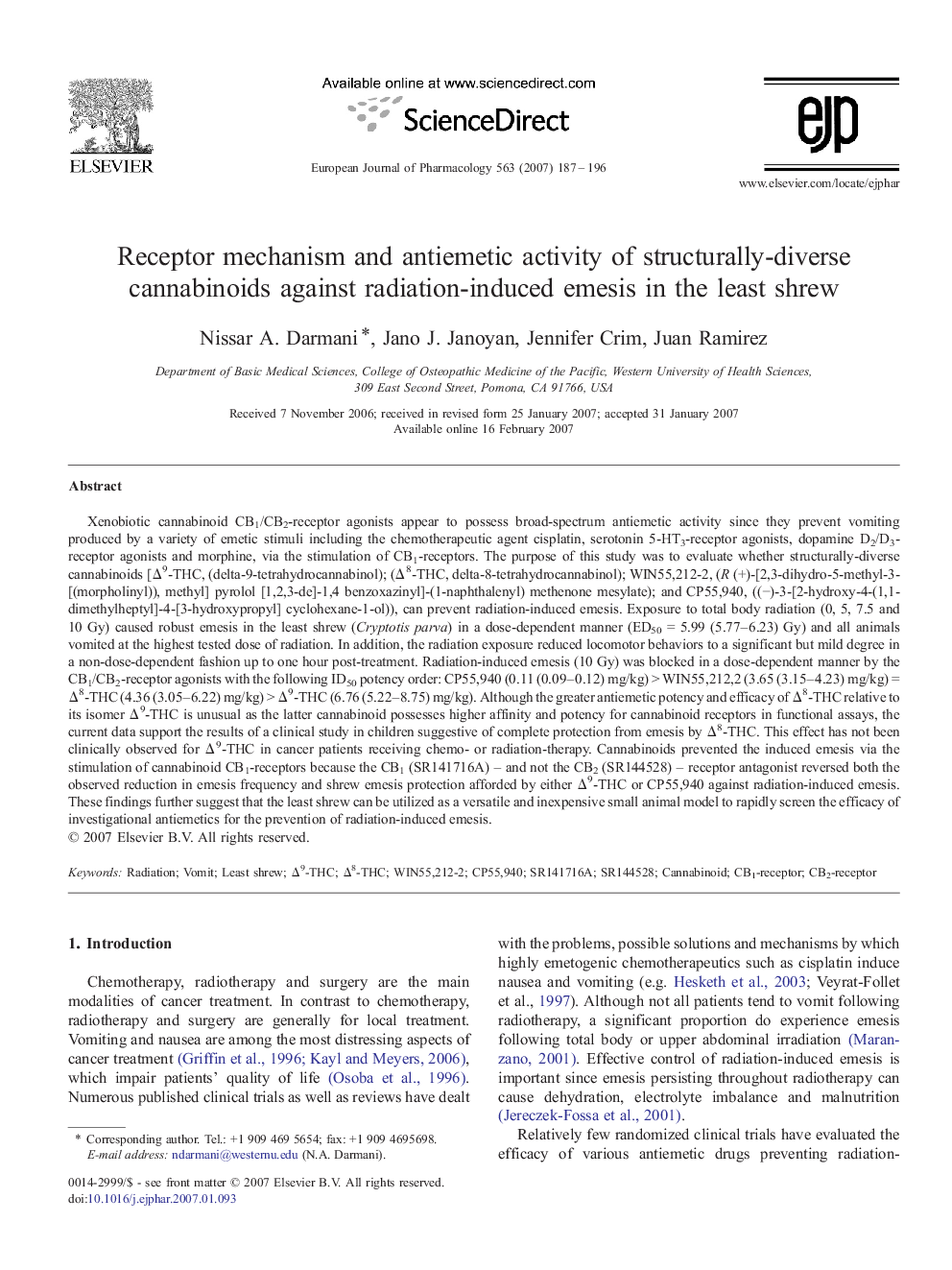| کد مقاله | کد نشریه | سال انتشار | مقاله انگلیسی | نسخه تمام متن |
|---|---|---|---|---|
| 2536343 | 1559146 | 2007 | 10 صفحه PDF | دانلود رایگان |

Xenobiotic cannabinoid CB1/CB2‐receptor agonists appear to possess broad‐spectrum antiemetic activity since they prevent vomiting produced by a variety of emetic stimuli including the chemotherapeutic agent cisplatin, serotonin 5‐HT3‐receptor agonists, dopamine D2/D3‐receptor agonists and morphine, via the stimulation of CB1‐receptors. The purpose of this study was to evaluate whether structurally‐diverse cannabinoids [Δ9‐THC, (delta‐9‐tetrahydrocannabinol); (Δ8‐THC, delta‐8‐tetrahydrocannabinol); WIN55,212‐2, (R (+)‐[2,3‐dihydro‐5‐methyl‐3‐[(morpholinyl)), methyl] pyrolol [1,2,3‐de]‐1,4 benzoxazinyl]‐(1‐naphthalenyl) methenone mesylate); and CP55,940, ((−)‐3‐[2‐hydroxy‐4‐(1,1‐dimethylheptyl]‐4‐[3‐hydroxypropyl] cyclohexane‐1‐ol)), can prevent radiation‐induced emesis. Exposure to total body radiation (0, 5, 7.5 and 10 Gy) caused robust emesis in the least shrew (Cryptotis parva) in a dose‐dependent manner (ED50 = 5.99 (5.77–6.23) Gy) and all animals vomited at the highest tested dose of radiation. In addition, the radiation exposure reduced locomotor behaviors to a significant but mild degree in a non‐dose‐dependent fashion up to one hour post‐treatment. Radiation‐induced emesis (10 Gy) was blocked in a dose‐dependent manner by the CB1/CB2‐receptor agonists with the following ID50 potency order: CP55,940 (0.11 (0.09–0.12) mg/kg) > WIN55,212,2 (3.65 (3.15–4.23) mg/kg) = Δ8‐THC (4.36 (3.05–6.22) mg/kg) > Δ9‐THC (6.76 (5.22–8.75) mg/kg). Although the greater antiemetic potency and efficacy of Δ8‐THC relative to its isomer Δ9‐THC is unusual as the latter cannabinoid possesses higher affinity and potency for cannabinoid receptors in functional assays, the current data support the results of a clinical study in children suggestive of complete protection from emesis by Δ8‐THC. This effect has not been clinically observed for Δ9‐THC in cancer patients receiving chemo‐ or radiation‐therapy. Cannabinoids prevented the induced emesis via the stimulation of cannabinoid CB1‐receptors because the CB1 (SR141716A) – and not the CB2 (SR144528) – receptor antagonist reversed both the observed reduction in emesis frequency and shrew emesis protection afforded by either Δ9‐THC or CP55,940 against radiation‐induced emesis. These findings further suggest that the least shrew can be utilized as a versatile and inexpensive small animal model to rapidly screen the efficacy of investigational antiemetics for the prevention of radiation‐induced emesis.
Journal: European Journal of Pharmacology - Volume 563, Issues 1–3, 1 June 2007, Pages 187–196